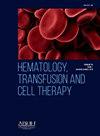THE PROGNOSTIC ROLE OF WHOLE BLOOD VISCOSITY AND BONE MARROW FIBROSIS IN PREDICTING SURVIVAL OUTCOMES IN NEW DIAGNOSIS MULTIPLE MYELOMA PATIENTS
IF 1.8
Q3 HEMATOLOGY
引用次数: 0
Abstract
Objective
This study aimed to evaluate the prognostic role of whole blood viscosity and bone marrow fibrosis in predicting survival outcomes and relationships with prognostic predictors, such as international scorin system albumin levels, beta2-microglobulin, total protein, albumin and lactate dehydrogenase in newly diagnosed multıple myeloma patients.
Case report
Methodology
We retrospectively evaluated 108 patients diagnosed with multıple myeloma between 2015-2022. Whole blood viscosity was calculated using the Simone formula, incorporating the haematocrit and total protein values. Bone marrow fibrosis was graded as mild (2), significant(3), or advanced. Comparisons of grade 0-3 bone narrow fibrosis and high-low calculated whole blood viscosity groups in terms of overall survival were conducted using the Kaplan-Meier survival curve and log-rank test.
Results
The median follow-up period was 16 months, and 57.4% of patients died during follow-up. The median overall survival was 26 months. The calculated whole blood viscosity (c-WBV) value predicted mortality with 88.7% sensitivity and 45.7% specificity. Patients with a high c-WBV (≥17.14 208 mPa-s) had significantly lower one- and two-year survival rates than those with a low c-WBV (<17.14 208 mPa-s) (p<0.001). Bone narrow fibrosis was inversely related to survival, with higher grades being associated with lower survival rates. The two-year expected survival time respectively bone narrow fibrosis 2 and 3 was determined to be 56.7% and 43.6% 41.4% and 23.3% (p<0.001). This study highlights the potential of whole blood viscosity and bone narrow fibrosis as prognostic markers in patients with newly diagnosed multıple myeloma patients.
Conclusion
Incorporating these parameters into the existing staging systems may enhance prognostic prediction and guide treatment decisions. Further prospective studies are warranted to validate these findings and explore the mechanistic links between whole blood viscosity, bone narrow fibrosis, and MM pathophysiology.
求助全文
约1分钟内获得全文
求助全文
来源期刊

Hematology, Transfusion and Cell Therapy
Multiple-
CiteScore
2.40
自引率
4.80%
发文量
1419
审稿时长
30 weeks
 求助内容:
求助内容: 应助结果提醒方式:
应助结果提醒方式:


